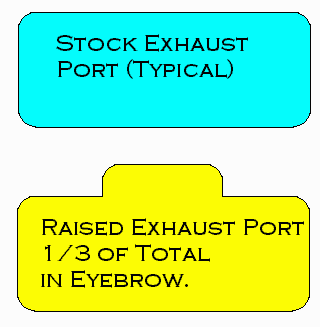|
Exhaust Port Shape & Timing
How Much Duration is TOO MUCH ?
The Lower the Exhaust Timing, the MORE Low End?
Introduction:
After a phone conversation a few days ago, I decided to provide you with a FACT. I was asked: "How much can you raise the exhaust duration without giving away to much low end?" "I have ALWAYS believed that the higher the exhaust timing the less low end the engine will provide." This seemed reasonable, so I never questioned it. I now know that this was BS ( someone showing how much (little) they knew). An engine has an area where it is MOST EFFICIENT in its Exhaust Open Duration AND in its Intake Open Duration. Note: In the ENGINE ANALYSIS PROGRAM, "duration time" is provided for the chosen timing.
Terminology: (Duration - open time of the exhaust port or the intake port)
How then can we decide what is the most efficient duration of any given engine? Very difficult without the availability of a dynamometer for testing, or a LOT trial and error guessing. The group of people that I spend my Winter Testing time with (John Ackerman, Brian Callahan, Joe Kramer, Norris Sparks and Bobby Coleman) have found out the answer to these questions. Here are those answers......
Exhaust timing:
The exhaust timing that we have found works the best is between 183 and 187 degrees of open time (duration). The lower being for 21 engines and the higher for 90 and 1 cu in engines. It is vital to be sure that for the increase in duration, you also increase the compression ratio and lengthen the pipe. The result will be BOTH an increase in HP and Torque!!!!
The shape of RAISED exhaust port we have found best is like this:

Intake Timing:
I have always felt secure that the intake timing that I have used for years was as good as I could choose. I have been persuaded that this is incorrect. I previously used 123-124 degrees for ALL engine sizes. In order to get correct intake and exhaust timeing, you need to do an in depth time/area analysis.
Remember that the fuel/air mixture is the main coolant for the engine. Keep the mixture on the rich side of the needle and you will see consistent performance and longer engine life. You don't need to burn a plug every run to know that your engine is performing correctly. I try to stay on that rich side of the needle (with the correct compression ratio), I keep the plug, and I get the performance.
|